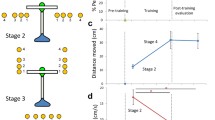Abstract
Results from three experiments on basic learning and transfer in rhesus monkeys (Macaca mulatta) are reported in which fully automated testing paradigms, afforded by the Language Research Center's Computerized Test System (LRC-CTS), were employed. Performance levels for discrimination learning set, transfer index, and mediational-learning testing were uniformly higher than was predicted from the literature, in contrast to previous reports of compromised learning under similar conditions (automated apparatus, planimetric stimuli, spatial discontiguity between stimuli and response loci). Analyses reveal relatively advanced learning set performance, transfer-index ratios, and positive transfer of learning even at stringent criterion levels. Moreover, the data suggest that rhesus monkeys tested in these experiments exhibit mediational instead of associative learning strategies, as do great apes and in contrast to previous reports of rhesus learning. We argue that the LRC-CTS enhances learning by nonhuman primate subjects, obviating those factors, reported in the literature from experiments in which manual or other automated systems were employed, that compromise learning.
Similar content being viewed by others
References
Davenport, J. W., Chamove, A. S., and Harlow, H. F. (1970). The semiautomatic Wisconsin general test apparatus.Behav. Res. Methods Instrument. 2: 135–138.
Essock-Vitale, S. M. (1978). Comparison of ape and monkey modes of problem solution.J. Comp. Physiol. Psych. 92: 942–957.
Fobes, J. L., and King, J. E. (1982). Measuring primate learning abilities. In Fobes, J. L., and King, J. E. (eds.),Primate Behavior, Academic Press, New York, pp. 289–326.
Harlow, H. F. (1949). The formation of learning sets.Psychol. Rev. 56: 51–65.
Jerison, H. J. (1973).Evolution of the Brain and Intelligence, Academic Press, New York.
Meador, D., Rumbaugh, D. M., Pate, J. L., and Bard, K. (1988). Learning, problem solving, cognition, and intelligence. In Mitchell, G., and Erwin, J. (eds.),Comparative Primate Biology, Vol. 2, Part B, Alan R. Liss, New York, pp. 17–84.
Meyer, D. R., Treichler, F. R., and Meyer, P. M. (1965). Discrete trial training techniques and stimulus variables. In Schrier, H., Harlow, H. F., and Stollnitz, F. (eds.),Behavior of Nonhuman Primates, Vol. I, Academic Press, New York, pp. 1–49.
Polidora, V. J., and Main, W. T. (1963). Punched card programming and recording techniques employed in the automation of the WGTA.J. Exper. Anal. Behav. 6: 599–603.
Pribram, K. H., Gardner, K. W., Pressman, G. L., and Bagshaw, M. (1963). Automated analysis of multiple choice behavior.J. Exper. Anal. Behav. 6: 123–124.
Richardson, W. K., Washburn, D. A., Hopkins, W. D., Savage-Rumbaugh, E. S., and Rumbaugh, D. M. (1990). The NASA/LRC computerized test system.Behav. Res. Methods Instrum. Comput. 22: 127–131.
Rumbaugh, D. M. (1969). The transfer index: An alternative measure of learning set. In Carpenter, C. R. (ed.),Proceedings of the Second International Congress of Primatology, Vol. 1, Behavior, Karger, Basel, pp. 267–273.
Rumbaugh, D. M., and Pate, J. L. (1984). The evolution of cognition in primates: A comparative perspective. In Roitblat, H. L., Bever, T. G., and Terrace, H. S.,Animal Cognition, Lawrence Erlbaum, Hillsdale, NJ, pp. 569–585.
Rumbaugh, D. M., Bell, C. L., and Gill, T. V. (1972). Two discrimination test apparatuses for primates.Behav. Res. Methods Instrument. 4: 6–10.
Rumbaugh, D. M., Richardson, W. K., Washburn, D. A., Savage-Rumbaugh, E. S., and Hopkins, W. D. (1989). Rhesus monkeys (Macaca mulatta), video tasks, and implications for stimulus-response spatial contiguity.J. Comp. Psychol. 103: 32–38.
Sidowski, J. B., and Spears, C. A. (1970). A versatile apparatus for measuring the frequencies and durations of animal and human responses.Behav. Res. Methods Instrument. 2: 235–238.
Stollnitz, F. (1965). Spatial variables, observing responses, and discrimination learning sets.Psychol. Rev. 72: 247–261.
Washburn, D. A., Hopkins, W. D., and Rumbaugh, D. M. (1989a). Automation of learning-set testing: The video-task paradigm.Behav. Res. Methods Instrum. Comput. 21: 281–284.
Washburn, D. A., Hopkins, W. D., and Rumbaugh, D. M. (1989b). Video-task assessment of learning and memory in macaques (Macaca mulatta): Effects of stimulus movement upon performance.J. Exper. Psychol. Anim. Behav. Process. 15: 413–420.
Author information
Authors and Affiliations
Rights and permissions
About this article
Cite this article
Washburn, D.A., Rumbaugh, D.M. Rhesus monkey (Macaca mulatta) complex learning skills reassessed. International Journal of Primatology 12, 377–388 (1991). https://doi.org/10.1007/BF02547618
Received:
Revised:
Issue Date:
DOI: https://doi.org/10.1007/BF02547618



